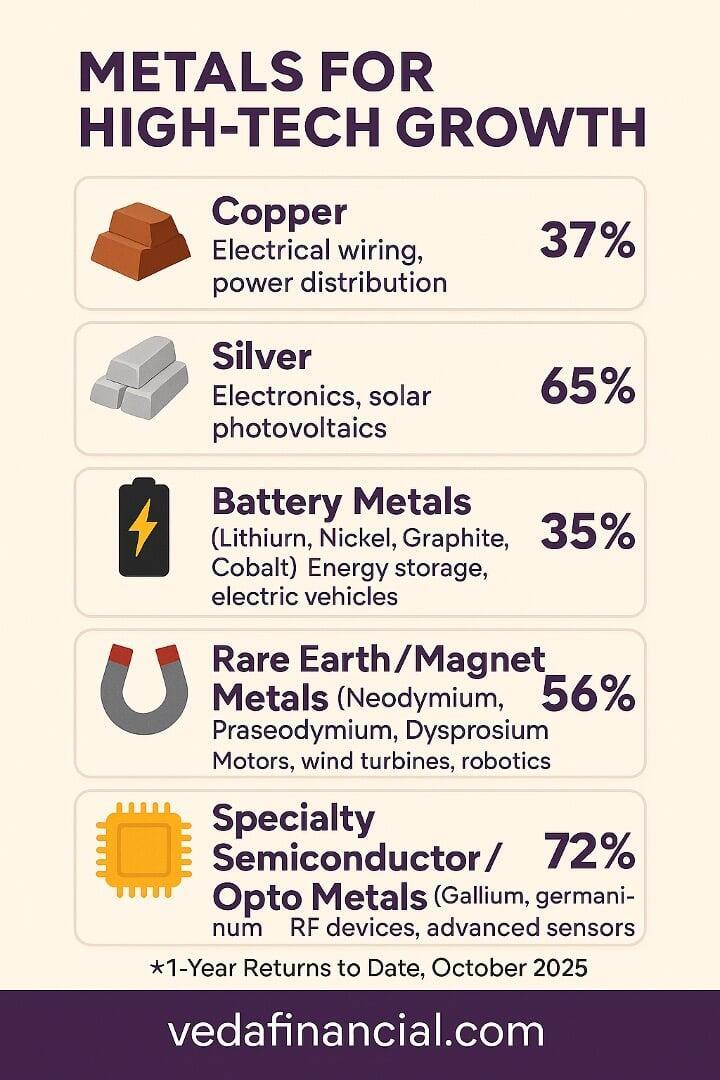Investing in Metals: The Unsung Backbone of the AI Revolution
Summary:
Artificial intelligence and high-tech growth aren’t just about algorithms or chips — they depend on the physical materials that make the digital world possible. As demand for semiconductors, EVs, robotics, and renewable infrastructure expands, a new investment frontier has emerged in strategic and industrial metals. While gold remains a timeless store of value, the real growth stories today lie in copper, silver, lithium, rare earth elements, and other materials essential to building the AI-driven future.
Why “Metals for High-Tech Growth” Is a Distinct Theme
Gold is primarily a hedge and store of value; its industrial use is limited. The metals that truly power AI and next-generation technologies are those with properties like electrical conductivity, magnetism, charge storage, and thermal stability. These materials form the backbone of wiring, semiconductors, magnets, batteries, and power systems that sustain global electrification and digital transformation.
From AI data centers and 5G infrastructure to EV batteries, robotics, and smart sensors — everything in the modern economy depends on advanced materials. Metals are, in essence, the raw input for intelligence at scale.
Complicating this story is supply: many of these metals are geographically concentrated and capital-intensive to produce. Expanding output requires new mines, energy, water, and regulatory approval — all of which take years. That combination of limited supply, slow scalability, and rising demand creates both volatility and opportunity for investors.
Key Metal & Material Categories: Growth Drivers and Risks
Below are the primary categories shaping the “metal economy” — why they matter, what’s driving their growth, and what risks investors should keep in mind.
1. Copper —
1-Year +2.5 %
Copper is the backbone of electrification. It carries power across grids, data centers, EV charging networks, and high-voltage systems, forming the wiring and cooling circuits that make modern infrastructure work.
The International Energy Agency projects copper demand to rise roughly 30 % in coming decades, led by renewables, EVs, and grid expansion. With an estimated 300 K–500 K-tonne supply shortfall this year, copper remains central to AI-scale electrification.
Cyclical and global-trade risks remain high.
2. Silver —
1-Year +65.5 %
Silver blends precious-metal appeal with industrial muscle. Its unmatched electrical and thermal conductivity makes it indispensable for circuit boards, sensors, solar cells, and semiconductor layers.
Industrial use now drives more than half of total demand, projected to grow ~9–10 % annually. Tight supply and robust solar expansion have powered one of the strongest performances among metals.
Volatile but increasingly supported by technology demand.
3. Battery Metals (Lithium, Nickel, Graphite, Cobalt) —
1-Year +19 %
These are the power metals behind the energy-storage revolution — from EVs to grid systems and AI data-center backup.
Lithium demand could rise 5× by 2040, while nickel and graphite double, according to the IEA. Oversupply caused temporary softness in 2024, but renewed EV momentum has lifted returns sharply in 2025.
Environmental and chemistry-substitution risks persist.
4. Rare-Earth & Magnet Metals —
1-Year +16 %
Rare-earth elements like neodymium and dysprosium create the permanent magnets inside EV motors, robotics, and precision cooling fans.
The global market is expanding ~6 % annually; magnet materials even faster. Despite moderate price performance, strategic value is high as the U.S. and EU race to diversify supply chains away from China.
High geopolitical and export-control sensitivity.
5. Specialty Semiconductor / Optoelectronic Metals —
Gallium, germanium, and indium underpin high-speed transistors, photonics, and RF devices. Demand for GaN-based chips and optical interconnects keeps rising, while export controls tighten supply.
Prices can swing on policy shifts rather than demand.
The Strategic Opportunity
In many ways, these metals form the industrial fabric of the digital era — the rails and wires of the AI economy. Their demand is rising not just from consumer electronics but from infrastructure-scale buildouts: hyperscale data centers, EV fleets, renewable grids, and industrial automation.
For investors, this means thinking beyond traditional commodities. A diversified metals allocation — spread across wiring (copper), industrial conductors (silver), energy storage (lithium / nickel), magnets (rare earths), and specialty semiconductors — can provide exposure to multiple megatrends at once.
However, metals are inherently volatile. Supply disruptions, policy changes, and cyclical slowdowns can trigger sharp price corrections. The opportunity lies in long-term positioning, not short-term speculation.
Takeaway
The “metal economy” is where the digital future meets the physical world. AI, automation, and clean energy cannot scale without the raw materials that make them possible. As investors look beyond traditional asset classes, strategic exposure to high-tech metals offers a way to participate in the real, tangible foundation of technological progress.
Disclaimer:
This article is for informational and educational purposes only and does not constitute investment advice or a solicitation to buy or sell any security. All information is based on current market data as of October 2025 and may change without notice. Investors should perform their own due diligence or consult a qualified advisor before making investment decisions.
Author:
Toni DasGupta, PhD, MBA, is CEO & Investment Advisor at Veda Financial Wealth Advisory @ Schwab. She specializes in customized portfolio management, holistic wealth planning, and strategic investing through major life transitions.
Veda Financial @ Charles Schwab
Individual, Company, IRA, 401K, Trusts
Registered Investment Adviser #173448
Life Insurance, Annuity & LTC Lic. #0I02070
⚠️ Disclaimer: This article is for informational purposes only and does not constitute investment, tax, or legal advice. Past performance is not a guarantee of future results. Investing involves risk, including possible loss of principal. Please consult with a qualified financial advisor before making investment decisions.
Veda Financial and its advisors may hold positions in some of the securities or industries mentioned.


